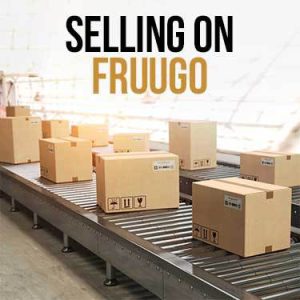
 Copy URL to Clipboard
Copy URL to Clipboard
Amazon is the king when it comes to online commerce in the United States, there’s little question about that. So it stands to reason that anyone selling products to consumers would want to be on Amazon’s prime platform. But maybe there’s a valid reason why you don’t want to sell through their website, yet don’t know of any alternatives to selling on Amazon.
However, the online giant isn’t the only game in town. There are many alternatives to selling on Amazon, plenty that could be just as good or possibly better depending on your objectives. Names like eBay, Walmart and other specialty sites can provide just what you’re looking for. Keep reading for a full scope on the subject.
Just as important as the platform that you sell your products on is the partner that you choose for fulfillment and distribution. Our team at R+L Global Logistics has the experience and knowledge to handle this critical step in the supply chain. Request a quote today to find out how we can meet your supply chain needs.
Table of Contents
If you only remember the days where you had to bid against others to secure your coveted goods on this website, then you haven’t been on eBay — which is at the forefront of the Amazon alternatives — in quite some time. While you can still try to score a deal via the auction system, eBay now has two things that make it a great place to sell you products: Buy It Now and eBay Marketplace.
The first option, Buy It Now, is still linked to the auction system. But with Buy It Now, the seller can also set an exact price that they are willing to accept for a sale that will automatically purchase the item on the buyer’s behalf. This isn’t much different than a regular purchase since you’re looking over a new or used product, deciding if the price is right and then checking out.
For eBay sellers, the Buy It Now option is used in conjunction with the auction system, so you can still receive bids on your products if that’s your preference while setting a price that you’re comfortable receiving that the buyer can trigger immediately. It is a win-win in that regard. eBay also has its marketplace, which is more like a traditional website setup for an online store. Here, you set prices like normal and customers buy.
The other major benefit to start selling on eBay is the secure marketplace. eBay has protections in place to protect both the buyer and seller and, in conjunction with accepting all major credit/debit cards and also its sister site PayPal, there are a myriad of safe ways to collect or make payments that should give both sides an additional peace of mind.
While it’s not a “downside” per se, eBay does collect a percentage on each sale made. So you will have to factor that into the prices you set in order to still hit your intended profit margin. However, this is no different than Amazon in that regard, so it’s not an additional cost versus selling on that site.

Years ago, it would have been unfathomable to sell your ecommerce goods with America’s largest brick-and-mortar retailer. But Walmart’s major expansion into the digital marketplace has been massive and now allows online sellers to tap in to their 100+ million visitors to their website each month alone.
Besides the ability to reach a lot of new customers that you might otherwise not have access to, your items are listed right alongside Walmart’s own listings. While there is a notation on your goods that they are being sold by an outside source, the listings aren’t any different
Walmart marketplace doesn’t make you pay a monthly fee to list items on their website like Amazon but you will be on the hook for a “referral” fee. Depending on what kind of commodity you’re selling, you will be charged a percentage ranging between 6 to 20 percent on each item sold.
Walmart allows sellers to list goods in more than 35 different categories and — while the retailer’s website is growing rapidly — there is still far less competition than on Amazon, which boasts over 2 million unique sellers. In addition, you will also see your products listed on Walmart’s other site such as moosejaw.com, jet.com and shoes.com.
Unlike a new website that hasn’t built credibility yet, the Walmart name is well-established and has the trust of consumers. Furthermore, Walmart accepts all major types of payments, so you can use a debit or credit card, or even some forms of electronic payment like PayPal.
Walmart.com, however, is not perfect for ecommerce sellers. Because Walmart’s mission is to offer customers the lowest price possible, there will be pressure on you to do so as well. In fact, if you listed your item for what Walmart deems to be too high a price, it has the ability to de-list your items. And in another contrast to Amazon, you will be expected to handle customer service for consumers who purchase your goods. Amazon usually does this for its sellers.
This deserves its own analysis since it is owned by Walmart but operates as its own marketplace. Bought by the large retailer in 2016, Jet.com has a lot of cool features that both buyers and sellers enjoy. From a buyer’s perspective, you can get additional discounts by taking small actions such as bypassing the option for free returns, providing your email address or adding a certain amount of items to your cart.
Sellers prefer it over other platforms in some cases because of its relative ease of use. You have to apply to be able to sell on jet.com and also have to be able to integrate into their Application Programming Interface, but their low fees and uncomplicated setup will entice both consumers and those selling their wares. Just a 15 percent commission is exacted by jet.com in many categories.

This is fairly similar to selling your goods with Walmart but there are a few differences to consider. Target is only courting currently established businesses, so newcomers to the field might not be approved. Even if you are more experienced in the retail forum, Target accepts businesses only by invitation.
Target Plus — as its online sales business is known — does offer its affiliated businesses a personal storefront on its website and just like with Walmart, sellers are strongly linked to a trusted brand in the Minnesota-based company. Unlike Walmart though, Target’s online presence is currently smaller.
Neither company offers you fulfillment options, leaving that to you or a third-party logistics (3PL) company you’ve contracted with to do work for you. Thankfully, we've got this covered for you. R+L Global Logistics is a full-service 3PL fulfillment and distribution provider. You can rely on us for all of your fulfillment needs.
Overstock.com, like several on this list, had modest beginnings but has since grown into a billion-dollar enterprise. Selling on Overstock is not much different than doing so on Amazon or eBay and can be lucrative.
For a seller, you must be approved by Overstock in order to peddle your wares on their website and you’ll be expected to handle all questions or returns, meaning Overstock doesn’t deal with customer support on your behalf. It is free to register, however, and you should encounter reasonable transaction fees. For instance, items $25 or under see a $0.10 listing fee and 3 percent transaction fee.
Your listings can also be spruced up through bold text and other flair for an additional cost, so you’ll need to create a budget beforehand to make sure you’re not overspending on needless advertising.
As a potential negative for selling on Overstock, customers flock to the site in order to purchase name-brand items. So if you’re selling off-brand or not widely recognized brands, then you might be better off elsewhere.
Overstock doesn’t have every category for items, but still emcompasses a wide range which includes but is not limited to:
For a buyer, the good thing about purchasing items on Overstock is your credit card info will only be shared with Overstock and not the third-party sellers, which becomes handy if you place multiple orders with different retailers on this site.
If you’re selling anything in the realm of electronics, whether it’s computers, their accessories, video games or anything adjacently related, NewEgg might be for you. This online electronics giant has branched out to include some other product categories such as:
As a seller, NewEgg is great for a few reasons. You just need to apply and tell the company about your business and there’s a good chance you’ll be accepted to begin listing your items for sale. You have the option to additionally promote your listings on the website and also do order fulfillment yourself or have NewEgg ship to the customers for you. As an additional benefit, NewEgg collects payments for you and then disperses them to you on a weekly basis.
The business does offer three tiered memberships for sellers: one is free, the Professional tier is $29.95 per month and the Enterprise tier is $99.95 per month. If you have a straightforward operation with 5,000 item listings or less a month, you can easily use the free tier. The two paid tiers do unlock more options and even discounts for sellers. As always, it’s important to do your own accounting and see if a paid tier will be ultimately beneficial to your business.
And customers love NewEgg for its sterling reputation for selling a variety of goods at competitive prices while allowing for returns.
Bonanza is another site where you can sell goods in a fashion like Amazon or eBay. While not as large as either of those companies, Bonanza does have some cool features that make it a worthy alternative to the traditional avenues of selling online.
For seller accounts, Bonanza sets up online marketplaces known as booths. This means instead of your items being listed all over the site, everything you’re selling is on one page which customers will see after clicking on an item they’ve searched for initially. This is great since it might allow you to sell multiple products to a customer at once.
Reasonable fees are also a trademark of Bonanza, where if you sold an item for $20, you’d be charged just 3.5 percent — or 70 cents. If you’re able to sell items for over $500, the percentage charged by Bonanza goes down as well. However, the site does institute a minimum of 50 cents per transaction, so this can cut into the sales of smaller valued products.
For a slightly higher percent fee, the website will actually advertise your item on the internet. Also, there are a large amount of different categories to list items in and you can sell both new and used items on Bonanza. Like some other sites, Bonanza does highlight popular brands but doesn’t make it mandatory for your items to be from well-known makers.

Fruugo is more seller-friendly from the perspective that you aren’t charged for a listing. You only pay a fee after the sale of your items. There are also no membership fees of any kind. You’ll also receive a dedicated account manager to offer assistance and also be able to accept payments in many different forms and currencies, which are converted into your currency of choice.
Fruugo has more of an international flavor as a UK-based company that ships to many countries that comprise 28 unique languages. Fruugo also provides complete protection against fraud and also has designed its interface to be friendly to mobile phones, desktop and tablets.
The only potential downside, if you want to even call it that, is it’s relatively new and small compared to other marketplace-style websites. Also, on certain items, the pricing seems to be inconsistent to what you can find at traditional retailers. So those are definitely things to keep an eye on.
This is another option that is in its own category since it is somewhat specialized. Alibaba is the world’s largest business to business marketplace. So you wouldn’t be selling individual items to consumers, but both small and large-scale orders to other businesses. AliExpress takes it a step further as it is mostly used as a dropshipping marketplace, meaning that you purchase items from a country such as China and AliExpress fulfills the orders on your behalf, allowing you to make a profit without having ever had the products in your actual possession.
The great thing for sellers about Alibaba or AliExpress is you have access to millions of customers all over the world who go to the two Ali sites because they’re trusted sources for inexpensive yet quality products in a large range of different categories. Alibaba, like some others on this list, have tiered memberships for sellers which run from a free basic membership that is somewhat limited to a premium one that unlocks all the options and benefits to the site.
However, Alibaba does share some of Amazon’s negatives as well. Both marketplaces are very high in competition, so it can be somewhat hard to turn a profit.
These two options are grouped together because they share the same setup, which is different from the other ecommerce websites. Basically, with Shopify and Square, you are paying them a monthly fee to allow you to have your own webpage and marketplace where you can sell all of your products.
From there, you can build a website with pre-made options, so you don’t need web design experience. Where Shopify and Square make their money is by being the platform in which payments are processed. Each takes a small percentage of the sale plus a small flat fee. You will do your own order fulfillment with these sites but it can be a preferred option if you’d like more overall control over your day-to-day operations.
These two sites also offer both customer and seller support, while also being able to share analytics with the seller to figure out why certain items sell well while others don’t. The other cool thing about both Shopify and Square is you can use them on the go, like if you’re in a real-life marketplace or festival selling your wares out in public.

Granted, this doesn’t have the same luster as having your own listings or marketplace on a site like Amazon but they do have some benefits that could make them attractive to those looking to maximize their profits.
First of all, let’s start with Facebook Marketplace. If you have a Facebook account, you can start a free marketplace profile and begin listing items. You have to list a price, description of the item and at least one photo, but that’s all it takes to be up and ready to sell. This takes more care and time to sell locally since you’ll be required to meet the buyer in person, which you should also do at a safe location during daytime hours to protect yourself. There are also not the same level of buyer or seller protections in place as Amazon. You will see pictures and profile information on Facebook, letting you familiarize yourself with the person you’ll be dealing with, which is a positive.
You can also choose to ship your items, but Facebook Marketplace — like many of the other sites — will charge a small percentage for any item not sold locally. This is of course safer than meeting in person but will cut a little more into your bottom line through shipping costs and Facebook fees.
Craigslist is also an option but doesn’t have the same level of safety. It might be completely unadvisable to ship items using Craigslist, since there’s no buyer or seller protection in place. You’re selling at your own risk. Craigslist does have a wide reach though, so selling locally could be lucrative. But just like meeting someone on Facebook, if you can’t stomach the idea of doing most or all transactions in person, Craigslist will not be for you.
If you’re planning on pursuing alternatives to selling on Amazon, you could probably use assistance on some of the front-end logistics by helping with fulfillment and distribution services. So look no further than R+L Global Logistics to get that helping hand you could use to take your ecommerce business to the next level.
At R+L Global Logistics, we can offer everything you’d need to successfully sell on any ecommerce site from eBay to Walmart and all formats in between. First off, we have ample 3PL warehousing space across the country to safely and securely store and then distribute your valuable goods.
Next, R+L Global Logistics can offer to fulfill all of your orders, which means utilizing our pick and pick services them from the shelves or shipping entire pallets and sending them directly to your customers. In addition to this full implementation, we are always available with industry-leading customer service to address any questions or issues you might have.
So when you’re ready to explore alternatives to selling on Amazon and need an outstanding partner to assist your operations, contact us via phone at 866-989-3082 for a free quote.
